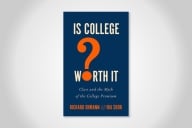You have /5 articles left.
Sign up for a free account or log in.
Any day now the U.S. Supreme Court will rule on Fisher v. University of Texas. The case concerns a lawsuit filed by Abigail Fisher, a white applicant who was denied admission to UT. Fisher argues that her race played a role in the admissions decision, and this, she claims, constituted a violation of her rights.
The higher education community is waiting apprehensively for the Supreme Court’s verdict. Many worry that the decision could drastically limit the ability of colleges and universities to be racially diverse.
Yet one feature of modern college admissions practices in the United States that can often be overlooked in this discussion is that white applicants receive a significant boost relative to Asian-Americans. This is among the findings of a major study by Princeton sociologists Thomas J. Epenshade and Alexandria Walton Radford, who also observe that Hispanic and African-American applicants receive a boost relative to whites.
According to the authors’ models, an Asian-American applicant must score 140 points more on the SAT out of 1600 than her white counterpart, all other things equal, to stand a comparable chance of admission at an elite institution.
The finding here is not just that the average admitted Asian student has a higher SAT score than her white counterpart. If that were all the data showed, then it wouldn’t support the inference that whites receive a boost relative to Asians, for the data would then be consistent with the hypothesis that despite having lower SAT scores, the average white applicant has better credentials in other areas.
On the contrary, what the data shows is this. Consider two applicants, Claudia and Alice, who have very similar applications for the most part. They both come from equally good high schools, have the same GPA, neither of them is a legacy or an athlete, and so on. However, Claudia is white and Alice is Asian-American. In light of this, Alice will have to score 140 points more than Claudia if she is to stand an equal chance of getting into an institution like Harvard or Yale Universities. And if their SAT scores are equal, then Alice’s application better be much more impressive than Claudia’s in some other respect(s).
Many see these statistics as a consequence of elite institutions using implicit quotas to limit the number of Asian students on campus. This charge forms the basis of an ongoing lawsuit filed against Harvard by Students for Fair Admissions, an anti-affirmative action group. The Education Department’s Office of Civil Rights recently cleared Princeton University of a similar charge. Notably, some Asian-American civil rights groups -- including Asian Americans Advancing Justice, Chinese for Affirmative Action and others -- have opposed these challenges, writing in an open letter, “Our universities should reflect our diverse democracy and expand opportunities for those students who have overcome significant barriers.”
Regardless of whether elite universities make use of an implicit quota system, it is still important to consider whether the boost given to white applicants relative to Asians is justified. Is the admissions process fair to applicants like Alice in the example above?
One prominent defense of preferential admissions appeals to historic injustice. If a group has historically faced unjust barriers to higher education, or other forms of systematic discrimination, then perhaps society has a reparations-based duty to correct for this. One way of doing so might involve taking reasonable steps to reduce underrepresentation of the said group in higher education.
It’s difficult to see, however, why this would apply to white Americans when contrasted with Asians. If anything, considerations of historical injustice militate in the opposite direction. America has a long history of explicitly discriminating against Asians. For example, the 1882 Chinese Exclusion Act, which arose as a result of anti-Chinese agitation, incorporated strict regulations to reduce immigration from China, and made it near impossible for resident Chinese laborers to obtain American citizenship. This policy continued in one form or the other until around World War II. Japanese-Americans have also had to suffer from policies directed against them, the most blatant of which was the directive to place large portions of the population into internment camps during WWII. Reparations-based justifications for white applicants are thus extremely hard to sustain in light of these and other historical facts.
A second justification for preferential admissions policies appeals to ongoing discrimination or implicit biases. If a particular group suffers from demonstrated implicit biases, then society presumably has a duty to correct for these biases -- a key part of which might involve preferential admissions to elite institutions. However, while studies report, for example, that African-Americans continue to face significant implicit biases in various contexts, it’s again hard to believe that American whites suffer from harmful biases relative to Asian-Americans.
Indeed, a major recent study suggests the exact opposite. Researchers sent emails to more than 65,000 professors at 250 highly ranked colleges and universities pretending to be students interested in their work. The results show that emails with Indian or Chinese names were much less likely to get responses. Moreover, the biases were found to be stronger in more lucrative fields, particularly in business academe.
The third, and possibly the most elusive, justification for preferential admission in this context appeals to the ideal of promoting diversity. If white applications were not given a boost in admissions decisions, one might argue, the campus would look too Asian. This outcome would be bad, and thus elite institutions should take steps to avoid it.
This argument raises an important question: How should we define “diversity” for the purposes of college admissions? There are many, many ways of dividing up a student body. Hence, we can think of a population as being diverse along many dimensions, including socioeconomic diversity, ideological diversity, religious diversity and so on. Why prioritize racial diversity?
Indeed, we don’t seem to care about a number of dimensions of diversity, and rightly so. Thus, suppose it turns out that men with beards, or Republicans, or heavy metal enthusiasts, are underrepresented in the Ivy League. That shouldn’t bother us. Why? Because plausibly, there is no duty based on considerations of social justice to “correct” for this underrepresentation.
In contrast, social institutions might have good reasons to prioritize racial diversity as such, if this is a necessary means of correcting past injustices or ongoing biases. If a racial group has suffered from discrimination in the past or continues to suffer from harmful biases, it is reasonable to argue that seeking to rectify underrepresentation of that group is a matter of social justice.
Often, the rationale behind seeking to correct for under- or overrepresentation of particular groups has to do with promoting equality of opportunity. However, as brought up earlier, the claim that whites in America are systematically disadvantaged relative to Asians is not very plausible.
Moreover, Epenshade and Radford find that if admissions policies were designed to give a boost to applicants coming from backgrounds of low socioeconomic status, without consideration of race, the number of admitted Asian students would rise substantially. This further undermines the notion that employing more demanding admissions criteria when it comes to Asian applicants promotes the goal of ensuring equal opportunity.
Regardless of the outcome in the case between Fisher and UT, the issue of whether preferential admissions policies based on race are justified in their current form merits further examination. While adequate justification may well be available in other cases, it is hard to see how giving a boost to white applicants relative to Asians is defensible in light of America’s historical and cultural context. And if no justification is forthcoming, social justice demands that these policies be significantly reformed.








